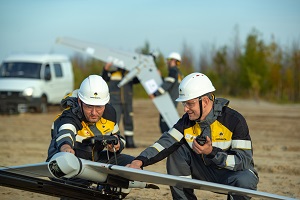Rosneft Develops Methodology to Measure Methane Emissions

As part of a target innovative project, Rosneft Oil Company’s specialists have developed a corporate methodology for quantifying methane emissions from fugitive sources at hydrocarbon production facilities.
The methodology is based on data from a comprehensive programme to detect and eliminate fugitive sources of methane emissions, which has been carried out at Rosneft’s production facilities since 2020. The Company has also utilised world’s best practices, scientific developments and state-of-the-art technology solutions to reduce greenhouse gas emissions, including methane.
Reducing greenhouse gas emissions is one of Rosneft Oil Company’s priorities in its operations. The Company shares and actively supports national and international goals in this regard. Rosneft pays particular attention to reducing methane emissions, with their specific potential impact on global warming being 25 times that of carbon dioxide.
The Company aspires to achieve net carbon neutrality for Scope 1 and 2 emissions by 2050 within the framework of its Rosneft 2030 Strategy. The strategy also formulates medium-term horizons for the climate agenda, which include reducing methane emission intensity to less than 0.2% by 2030.
In 2022, Rosneft scaled up this integrated monitoring programme using unmanned aerial vehicles (UAVs) and ground surveys featuring laser and ultrasound detectors, as well as multispectral infrared cameras for optical imaging of gases using cryogenic technology.
 The number of enterprises where methane emission sources have been monitored by UAVs has reached 17 in the two years of the programme implementation. The surveys were conducted twice a year, with more than 500 on-site inspections covering more than 123 km2, and around 4,800 km of gas pipelines. In addition to controlling methane emissions, this has improved the integrity of oil and gas transportation infrastructure and hydrocarbon treatment facilities in terms of industrial and environmental safety.
The number of enterprises where methane emission sources have been monitored by UAVs has reached 17 in the two years of the programme implementation. The surveys were conducted twice a year, with more than 500 on-site inspections covering more than 123 km2, and around 4,800 km of gas pipelines. In addition to controlling methane emissions, this has improved the integrity of oil and gas transportation infrastructure and hydrocarbon treatment facilities in terms of industrial and environmental safety.
More than 280 locations were surveyed during ground surveys at the production sites of 20 enterprises. The application of a full range of advanced technology solutions for on-site ground surveys, combined with UAV monitoring, helps identify anomalies and localise emission sources on site. This combination makes it possible to detect the source and its cause, develop a set of remedial measures and eliminate deviations, however small, from the strict standards of oil and gas field development.
The Company has also developed a generic programme of measures to detect fugitive methane emission sources at hydrocarbon production facilities, taking into account world’s best practices and regulatory recommendations in this area.
The introduction and development of the methodological framework will improve the efficiency of methane emission reduction and contribute to the Company’s strategic goals of decreasing its carbon footprint.
Note for Editors:
Methane is a climate-active gas that remains in the atmosphere for about a decade. 60% of methane comes from anthropogenic sources, most notably agriculture, which accounts for about a quarter of its total emissions. Energy resources (gas, coal, oil and biofuels in descending order) come second, followed by landfill and biomass burning.
Combating climate change is one of the UN Sustainable Development Goals that can only be achieved through a high level of cooperation between governments, civil society organisations and businesses. In 2019, Rosneft joined the initiative of the world’s leading oil and gas companies, “The Guidelines for Methane Emission Reduction in Natural Gas Supply Chain”. This initiative provides for the following:
- consistent reduction in methane emissions,
- performance improvement (methane emissions management) in the gas business value chain,
- improvement in the accuracy of methane emission data,
- promotion of sound policies and regulations on methane emissions,
- greater transparency in reporting.
Rosneft
Information Division
December 12, 2022